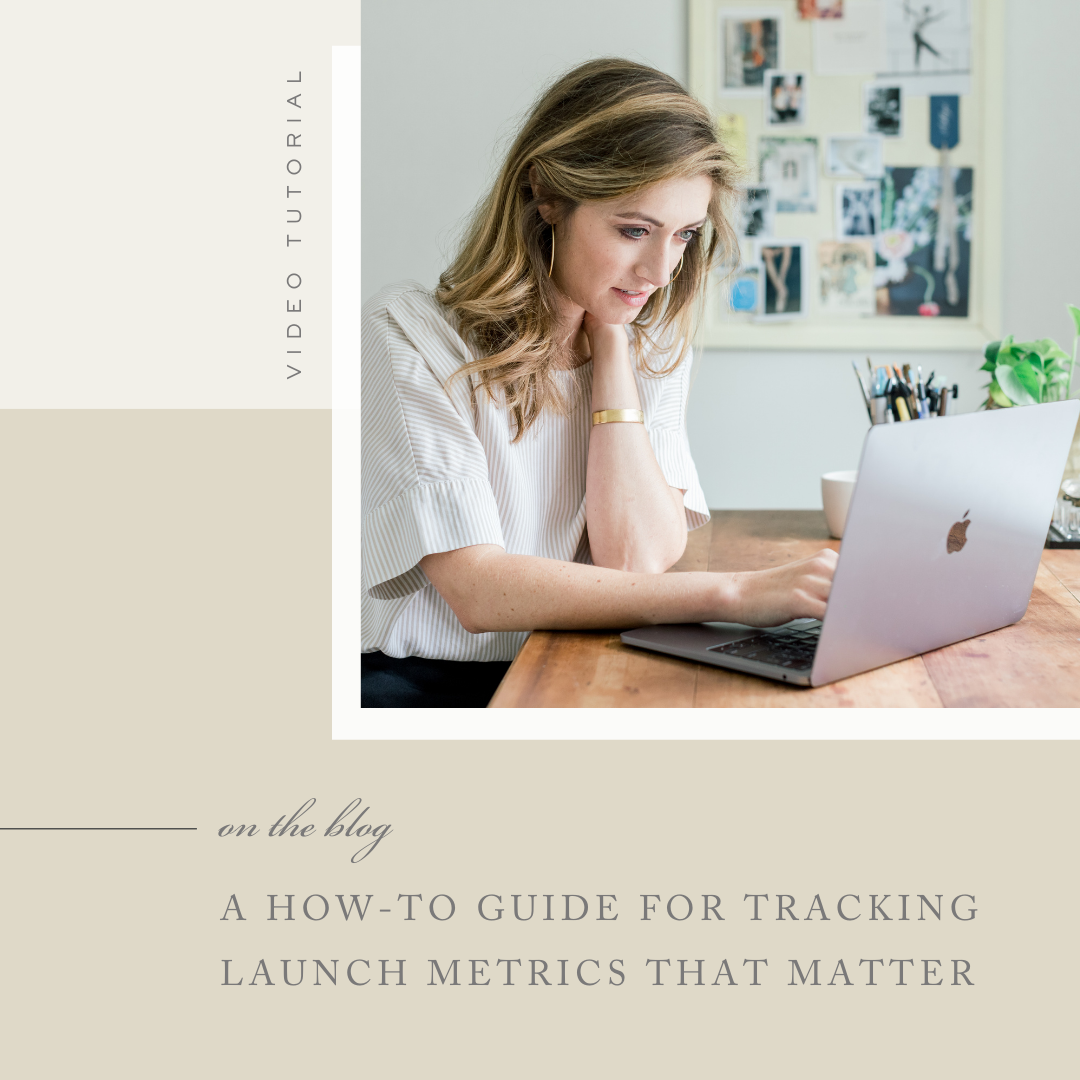Today, I’m showing you some of the steps to go through to run launch metrics on past launches you’ve had or any upcoming marketing campaigns you’re planning.
Because finishing up a launch or a marketing campaign and having NO clue if it was good or bad or worse, feeling like it did not meet your expectations, can be incredibly frustrating.

By the end of this post, you will learn 3 steps to go through to begin to map out your launch metrics and see if your launch was a success or not.
I’m also taking you behind the scenes and showing you something I’ve NEVER shared on the internet before—it is a launch recap in a report template. I have this saved in my Google Drive and I LOVE it, I use it all the time. Best part? I’m also telling you how you can snag a copy for yourself.
All that said, let’s get into those 3 tips.

Launch Metrics Tip No. 1| Set your launch goals.
I’m not JUST talking about your sales goals here.
I tell my students inside my program Primed to Launch™, that there are five different arenas that I would like for you to set goals and then capture metrics.
Five Areas to Set Goals & Capture Metrics
- Brand awareness. What do people actually know and think about your brand? Also spoiler, this one’s typically harder to measure than the other four I’m gonna walk through.
- Engagement. How do people interact with pieces of the marketing campaign you were pushing out? +Lead generation. As a result of your marketing campaign or launch who’s knocking on your door and wanting to work with you, either in some kind of capacity that you launched as part of the offer, or this is the auxiliary bump that happens with a good launch. People, you’re back on their radar, and now that you are on their radar, they wanna work with you in either some other type of capacity. Purchase something else that you offer or partner with you in some kinda way.
- Sales.
- Customer retention. On the back end of your launch and marketing campaign, do these people even want to stick around or do they, they didn’t get what they bargained for, they want a refund. Those kinds of things we need to look at as well.
Okay, I’m gonna show you a post-launch campaign and how to unpack all of this, but before we even get there, we have got to set some goals and metrics to aim for in all five of these categories.
I constantly see students and just people in my audience feel disappointed after a launch, and I really think that there are two culprits that come to play here–>1) They didn’t set any expectations or goals to begin with, they just had an arbitrary number in mind, and that leads. 2) Because they didn’t have necessarily specific goals, they just, for lack of a better word, kind of drank the Kool-Aid that launch culture pushes down on us.
I think after hearing soooo many times people have a 5,6,7 figure launch, we don’t realize that we internalize some of that. Then we’ll have our own launch and it maybe doesn’t hit that, and we think it was a failure. This is why, copywriter though I may be, I love data so much because it tells a story. Yes, I can feel a certain way about my marketing campaign or my launch, but I’ve got to actually look at the numbers, look at the facts of the matter and then assess and determine how things actually went based on that.
Here’s my solution to all of that: set realistic goals.

Let’s talk numbers: I tell clients to plan on converting about 3-5% of your WARM leads, your “launch list” leads, during the entiiiiire launch funnel—that includes your overall average from your landing pages and email campaigns.
I also want to caution that actual on-page landing rates MAY be lower than you think—of every 100 visitors on your landing page, 2.35 get converted into leads according to an IMPACT study. I don’t know if that seems low or high to you, some industries see significantly higher conversions, others fall well below that line. So many factors affect that too, from the hook, to the kind of text used, obviously the offer itself, images and videos, the number of CTA buttons, etc. I’ve done a video in the past where I dig into how to a conversion rate of a page, —you can watch that here.
What’s a good conversion rate for a website? The top 25% of websites as a whole, so not just one landing page but the whole website, convert at about 5.3%. Stick with me, I’m gonna throw a few more numbers to you that may be of interest because they’ll apply to your specific industry or niche. With business consulting, shout out to coaches out there, it’s about 5%. Travel websites, we have a few students who do that, 5%. Job training websites convert a little higher, about 6%. E-commerce is historically a little lower. I’d dug up a study that showed in 2019, this was a LittleData. study, the conversion rate for that website typically is more around 1 to 4%.
Okay, clear as mud, right?!?

That was a lot of numbers I threw at you, but here’s the overall takeaway—it takes A LOT of volume to have a successful launch. It takes a lot of eyes moving into that funnel, landing on that sales page, offer page landing page, checkout page itself, to see a big volume turnout on the other side in sales. This is why I made Prime to Launch™, I think it’s SO important you prime your audience for the offer.
We even had a launch client tell us after we worked together. She said, “I totally get why people focus on list building now though”—she realized that it takes a big volume to likely hit those numbers that you may be dreaming of. Let me say this again, it’s not a good thing or a bad thing, I just want you to manage your expectations. Yes, there are unicorns out there, they’re runaway success stories, but these are just good places to start when you’re setting your goals, like you’re doing here in step 1.
Like I was talking about, brand awareness is typically a little more difficult to measure, and there’s gonna be some intangible stuff that happens with your launch. For example, I swear we always have people, when we go through a launch in my own business, that’ll say, “Oh my gosh, I had no idea that you do this. I am saving up. I’m coming for you. I’m gonna purchase this in six months or in a year.” Those kinds of things you don’t always hear about, but that’s going on in people’s heads too, so don’t forget that that may be going on.
Action step: I want you to go back, write those five categories down, those arenas I want you to start measuring, and journal through some ideas that you have for your upcoming launches that you have planned for 2021 and goals you wanna hit in those categories.
Related: My WINNING Idea Validation Workflow for Pre-Launch Marketing
Launch Metrics Tip No. 2 | Reporting.
This one’s hard for me personally, because after a launch I want to lay on the couch and eat bonbons and take naps(anyone else?!). Buttttt I make myself.
I tell this to clients and students as well, you need to do THREE types of reporting. Financial tracking, duh, stats tracking (pulling numbers that matter that aren’t necessarily directly financial numbers—email open rates, click-through rates, Facebook ad stats), and a mental download of wins, losses, and other things to fix, tweak, and repeat. Even personal things, like, next time let’s put a sticky note on the wall for each sale we want to make or make sure to put in the Instacart order early in the week for snacks These sound silly, but if you’re following that Quarterly Champagne Campaign four launches a year outline that I give you, I talked about it in last weeks video on my YouTube channel, there’s a space between your launches and you don’t always remember these things—or at least I don’t.;)
Next up, I’m tracking this all in my launch metrics report + debrief template. This doc has been LIFE-GIVING for me to run after a launch. This is the launch recap in the reporting moratorium, for lack of a better word, that I go through. This doc is saved as a template in Google Drive and I’m running through some tips below so you can set up your own! I have also dropped a copy of it inside module 4 of the Prime to Launch™ Masterclass Series, voila!
Here is a quick peak at what this looks like:
Launch Metrics Report + Debrief Template Recap
- Start with your goals.
- Sales Reporting.
- Engagement Reporting.
- Lead Generating Reporting.
- Financial reporting.
- Wins, challenges, ideas for next time, product changes to make.
I hope this is helpful so you can create something like this yourself, and if you need more assistance here, you can see a behind the scenes look at this template in this video here. Again, I just slid it inside the 4th module of the Prime to Launch™ Masterclass Series. If you want access to it, to keep your own files, wallah, there it is.
Launch Metrics Tip No. 3| Optimistically plan for next time.
You set your goals, you ran the launch and you walked through in the last step, step 2, that recap plan I showed you. You typed up the overall report but now I would pick 4-5 takeaways that you can actually implement for the next time.
This is something I love helping our clients with. Sometimes it’s hard to see the back of your hair, but figuring out, okay, we have this data, this information, what steps can we take going forward to make it better for next time.
It’s going to be hard to do everything on your list. If you’re like me, I’m an overachiever and I wanna do ALLL of them, but I found realistically, I could probably make 4-5 big tweaks to the next launch, and it’s time to go again. This also makes it easier when you go back to step number 1 at the top of this post, and you’re setting your goals for a new launch. If you’ve done this well and you’ve gotten to the end of the campaign, you’ve written out what you’re gonna change, those can be your goals for next time— it’s all working together.
Related: Planning to Launch Soon? Here’s What You NEED to Know
And there you have it. If you want even more ideas about planning your upcoming launches, priming your audience with content that actually converts and move the needle, then be sure to look down below. You can get your hands on my Primed to Launch™ Playbook. It’s my answer on how to strategize, organize and craft marketing content that power glides into your upcoming launch. You have the option to to add on the masterclass series, where I take you behind the scenes more, give you some over the shoulder videos and tutorials. It’s a little bit more bonus content if you want that.
Now you know how to measure the success of your 2021 launches, but what about how to even create that marketing plan to begin with for a new calendar year? We’ll be sure to watch this video next—it’s all about how I set a marketing plan for the year.
Here’s to working from a place of more rest, less hustle. 🥂

LOVE THIS SLASH NEED IT BACK-POCKETED FOR LATER?
CLICK BELOW TO PIN IT!

Reading Time: 8 MinutesReading time: 8 min. Today, I’m showing you some of the steps to go through to run launch metrics on past launches you’ve had or any upcoming marketing campaigns you’re planning. Because finishing up a launch or a marketing campaign and having NO clue if it was good or bad or worse, feeling like it […]



comments +